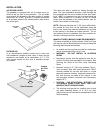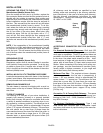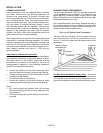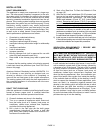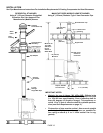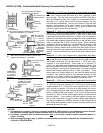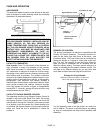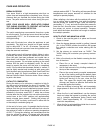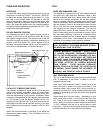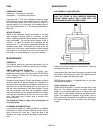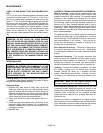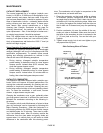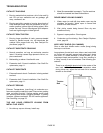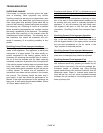CARE AND OPERATION
PAGE 16
BREAK-IN PERIOD
Your stove finish is a high temperature paint that re-
quires time and temperature to completely cure. We rec-
ommend that you ventilate the house during the initial
burns. The paint emits non-toxic odors during this proc-
ess.
KEEP YOUR HOUSE WELL VENTILATED DURING
THE CURING PROCESS TO PREVENT ACTIVATION
OF YOUR HOME SMOKE DETECTOR.
The paint manufacturer recommends three burn cycles
to cure the paint. The first two burns should be low heat,
approximately 250° F., for 20 minutes each, using paper
and light kindling.
After each 20-minute burn, allow the appliance to cool
completely. The third burn should be at least medium
high or about 450° F. for 45 - 60 minutes. The paint will
become soft and emit non-toxic haze during these burns.
Keep the area well ventilated.
As the paint cures it will become slightly lighter in color.
Eventually the entire surface will become an even color.
Once the paint has been softened and cooled two or
three times, it will harden. Do not turn on a blower during
the curing process. Do not place anything on the stove
surface until the paint is completely cured. Do not at-
tempt to repaint the stove until the paint is completely
cured. If the surface later becomes stained or marred, it
may be lightly sanded and touched up with spray paint
from the same paint manufacturer (See Small Area Paint
Touch-Up, page 18). Paint is available at your local au-
thorized Lennox Hearth Products dealer. Never attempt
to paint a hot stove.
CATALYTIC COMBUSTOR
During the start-up of a cold stove, a medium to high fir-
ing rate must be maintained for about 20 minutes. The
high firing rate will ensure that the stove, the flue, the
catalyst, and the fuel are all stabilized at proper operat-
ing temperatures. Even though it's possible to have tem-
peratures in the stove reach 600° F. within two or three
minutes after the fire is started, do not set the primary air
control lever to the "LOW" position until approximately
twenty minutes have passed. Setting the primary air
control on "LOW" too early could result in either the fire
or the catalytic combustor going out.
At the end of a burn cycle, it's possible that the hot em-
bers remaining might not provide sufficient fuel value for
the catalyst to retain its minimum operating temperature
of 600° F. During the refueling, we recommend that the
stove be refired for about 10 minutes with the bypass
open to ensure a good draw is established and that the
catalyst reaches 600° F. The refiring will ensure sufficient
temperatures and proper amounts of volatiles for the
catalyst to operate properly.
When refueling a hot stove with the catalyst still operat-
ing, no refiring step is necessary. Just open the bypass,
set the primary air control to high, open the door ap-
proximately ½” (1 cm), and wait for about thirty seconds.
Load the fuel, close the door, close the bypass and set
the primary air control to normal operation. Tempera-
tures within the firebox should be hot enough to maintain
the catalytic operation.
HOW TO START AND MAINTAIN A FIRE
1. Check to be sure the grate is in place and the ash
drawer is closed.
2. Open the bypass damper control by pulling it toward
you. In the "OPEN" position the draft air will bypass
the catalytic combustor and make starting the fire
easier.
3. Set the primary air control lever on "HIGH". The
"HIGH" setting will maximize your primary combus-
tion air.
4. Build a fire directly on the firebrick covering the bot-
tom of the stove.
a. Place five or six loosely crumpled sheets of
newspaper in the stove.
b. Add a small amount of dry kindling randomly on
the top of the newspaper.
c. Place a few more loosely crumpled newspapers
on top of the kindling and light the bottom paper
first, then light the top paper. Once the kindling is
ignited and burning on its own, close the fuel
door. The upper fire should help preheat the
chimney and create an effective draft while the
lower fire ignites the kindling.
5. When the kindling is burning well, add increasingly
larger pieces of wood until the fire is actively burn-
ing.
6. When the fire is well established, use the damper
hook and close the bypass by pushing the control
rod in (catalytic temperature probe should read
600°F, takes approximately 20 - 25 minutes to
reach this temperature).
7. When the fire is well-established slide the air control
lever for the desired heat output.



